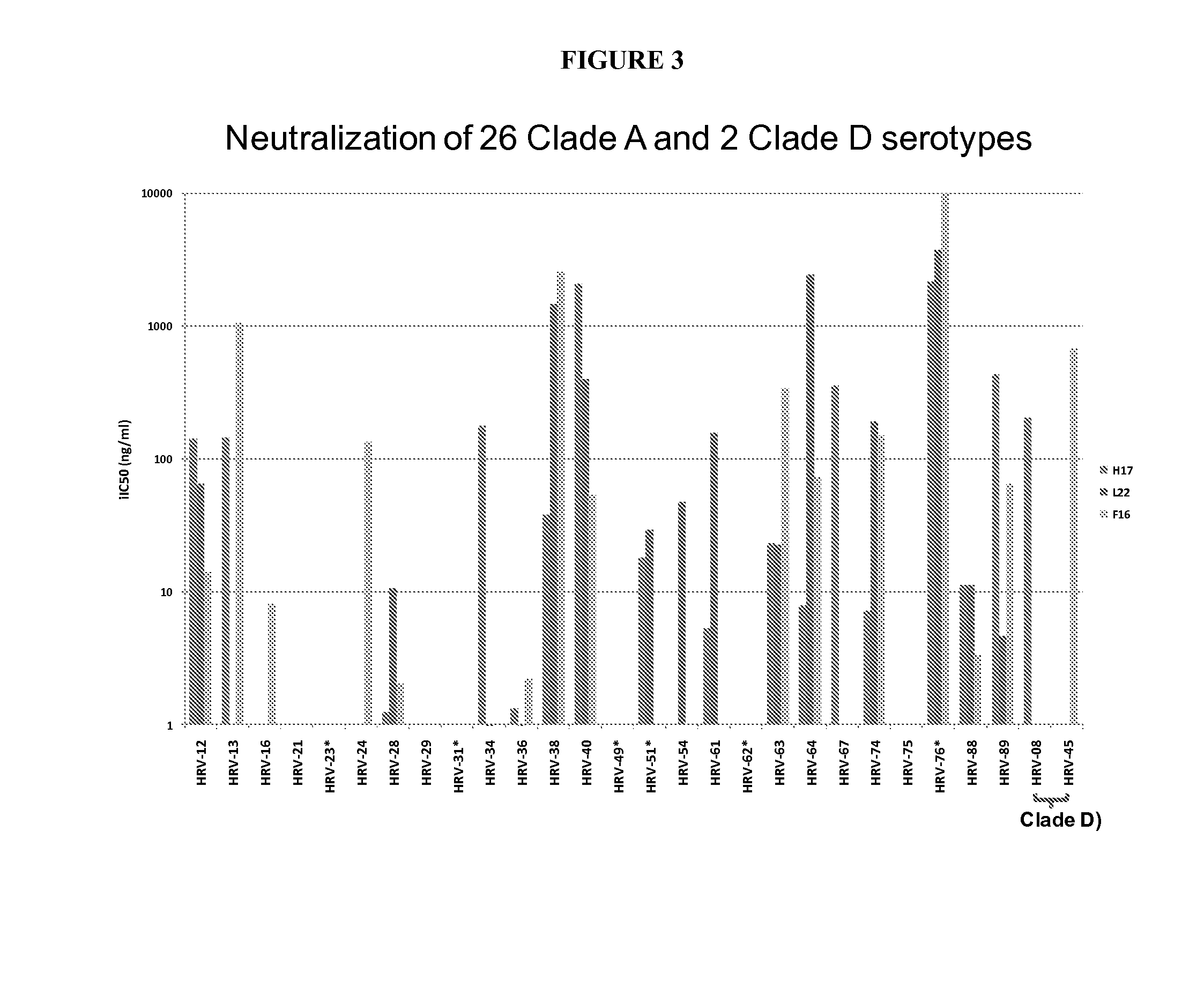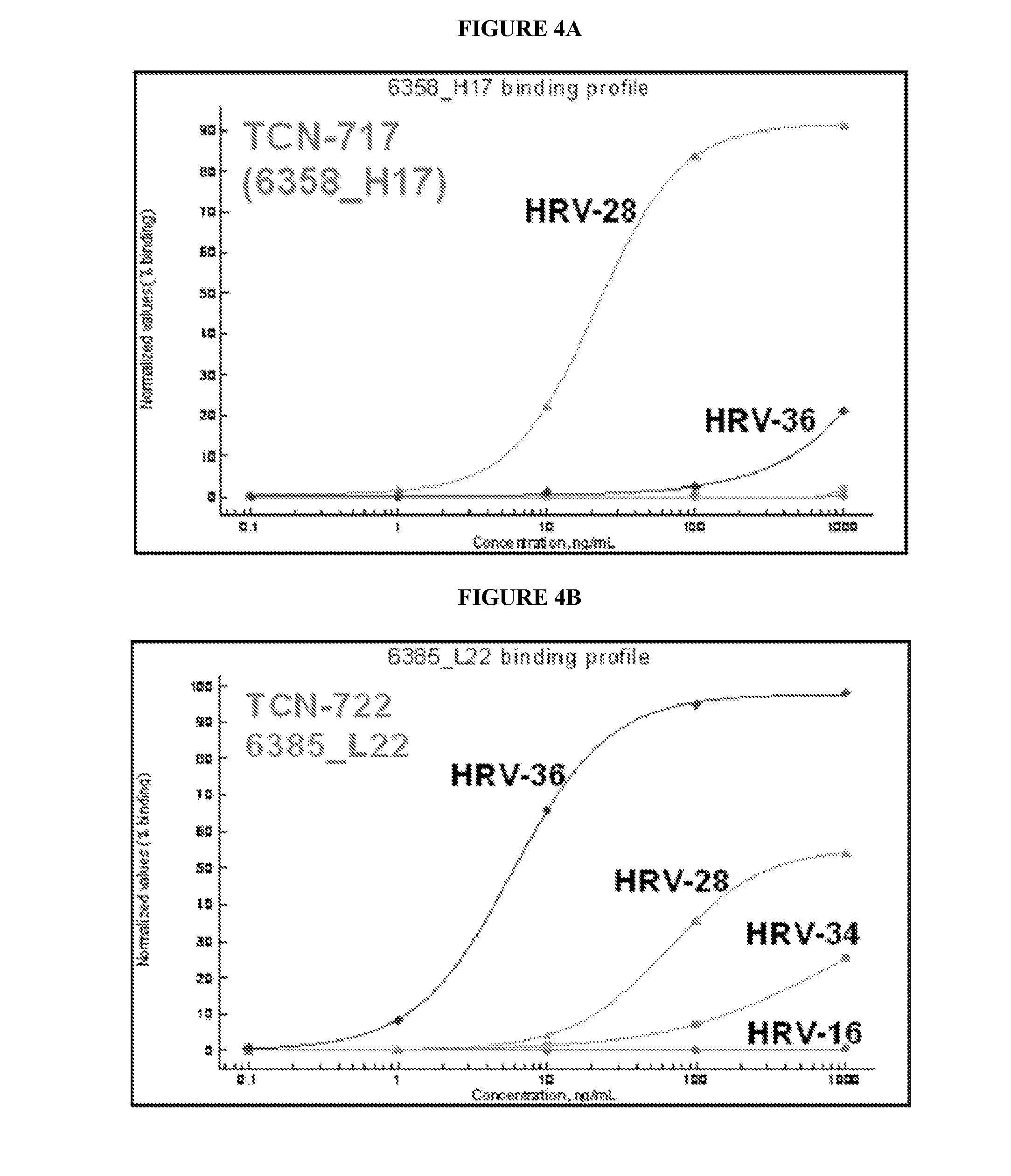Human rhinovirus (HRV) antibodies
a human rhinovirus and antibody technology, applied in the field of human rhinovirus neutralizing monoclonal antibodies, can solve the problems of lost educational opportunity and productivity, and the inability to detect human rhinovirus infection,
- Summary
- Abstract
- Description
- Claims
- Application Information
AI Technical Summary
Benefits of technology
Problems solved by technology
Method used
Image
Examples
example 1
Isolation and Characterization of Cross-Serotype Neutralizing Monoclonal Antibodies Against Rhinovirus
[0385]IgG expressing memory B cells were isolated from a healthy individual by negative depletion of other peripheral blood mononuclear cells (PBMC) on magnetic beads. Memory B cells were activated at near clonal density in 384-well microplates in the presence of cytokines and feeder cells that promote polyclonal B cell activation. Supernatants of B cell culture wells containing secreted antibodies were screened for neutralization against 2 serotypes of rhinovirus (HRV) in cytopathic effect (CPE) assay. Variable regions of the IgG heavy and light chains from the B cell clones that neutralized both serotypes were rescued by RT-PCR and the sequences were determined by 454 pyrosequencing (also known as deep sequencing). The sequences from an individual B cell clone were then compared with those from other B cell clones to identify clonally related antibodies also known “sister” mAbs. T...
example 2
Isolation and Characterization of Cross-Serotype Non-Neutralizing Monoclonal Antibodies Against Rhinovirus
[0387]Memory B cells were isolated from a healthy individual different from the one described in Example 1 using similar method. B cell culture supernatants were screened for cross-serotype binding reactivity by capturing human IgG on microarray glass slides and incubating with inactivated virus of ten different serotypes separately. Variable regions of the IgG heavy and light chains from a B cell clone, TCN-711 (or E11), that bound to nine serotypes were rescued by RT-PCR and the sequences were determined by deep sequencing. The variable regions were synthesized as DNA and cloned in an expression vector with IgG1 constant domain and another one with Igλ constant domain. Monoclonal antibodies were reconstituted by transient transfection in HEK293 cells followed by purification from serum-free culture supernatants.
[0388]Purified TCN-711 was analyzed in a titration series of conce...
example 3
Isolated Anti-HRV Human Monoclonal Antibodies Broadly Neutralize HRV-A and / or Broadly Bind HRV-A, HRV-B, and HRV-C
[0389]Human rhinovirus (HRV) is a common causative agent for respiratory tract infection and frequently triggers acute exacerbations in chronic respiratory disease in high risk patient populations. HRV may be classified as 3 distinct species, including HRV-A, HRV-B, and HRV-C. Infection by HRV-A and HRV-C are also more severe HRV-B, and, therefore, may be considered more prevalent due to increased reporting to medical professionals. HRV-C can cause severe lower tract respiratory infection in infants associated with febrile wheeze and a correlation with an increased risk of onset of childhood asthma, which many children overcome as their development continues.
[0390]Activated memory B cells from human subjects were screened ex vivo for neutralization or binding activity against multiple HRV-A / HRV-B strains. IgG variable genes of cross-reactive mAbs were cloned from individ...
PUM
| Property | Measurement | Unit |
|---|---|---|
| incubation time | aaaaa | aaaaa |
| temperature | aaaaa | aaaaa |
| half-maximal inhibitory concentration | aaaaa | aaaaa |
Abstract
Description
Claims
Application Information
 Login to View More
Login to View More - R&D
- Intellectual Property
- Life Sciences
- Materials
- Tech Scout
- Unparalleled Data Quality
- Higher Quality Content
- 60% Fewer Hallucinations
Browse by: Latest US Patents, China's latest patents, Technical Efficacy Thesaurus, Application Domain, Technology Topic, Popular Technical Reports.
© 2025 PatSnap. All rights reserved.Legal|Privacy policy|Modern Slavery Act Transparency Statement|Sitemap|About US| Contact US: help@patsnap.com



